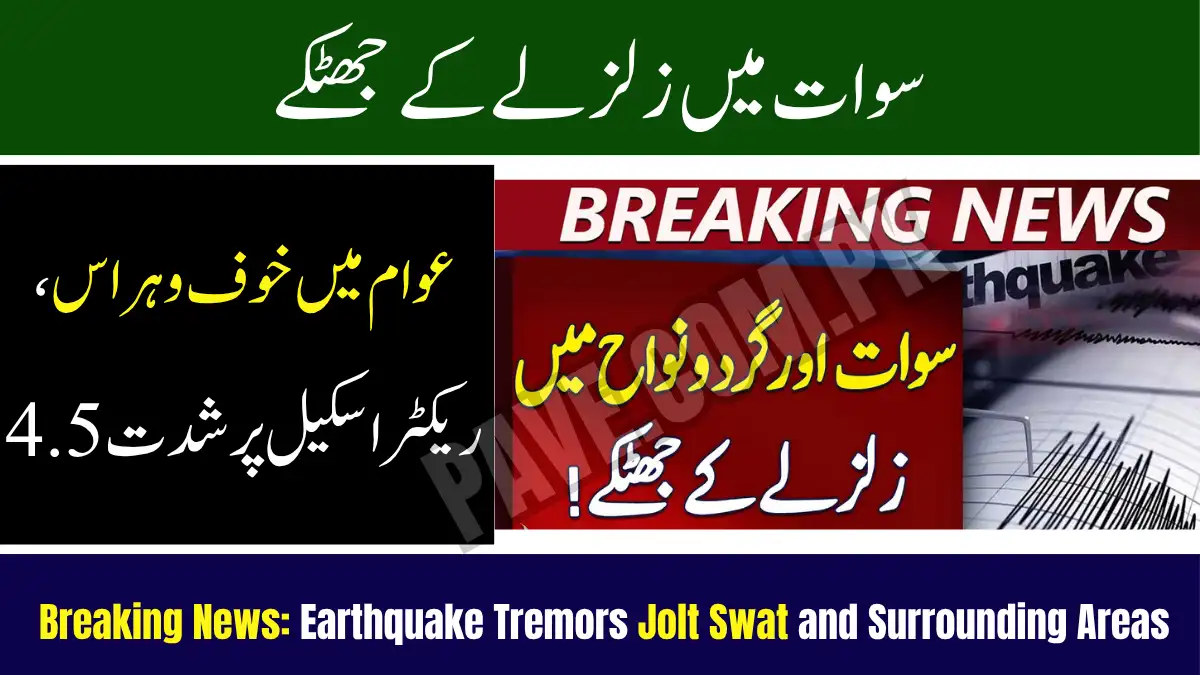Breaking News: Earthquake Tremors Jolt Swat and Surrounding Areas – Magnitude 4.5 Recorded on Richter Scale
Panic spread across Swat and its surrounding areas on Sunday afternoon as moderate earthquake tremors were felt across the region. According to the National Seismic Monitoring Centre (NSMC), the earthquake measured 4.5 in magnitude on the Richter scale, with its epicenter located in the Hindu Kush mountain range at a depth of 50 kilometers beneath the surface.
Residents in Mingora, Kabal, Matta, and nearby towns rushed out of their homes and shops as the tremors struck, creating scenes of alarm and fear. Fortunately, no casualties or property damage have been reported so far.
Authorities have advised citizens to stay alert and prepared for potential aftershocks, as minor seismic activity is expected in the region over the next few hours.
Swat Earthquake 2025: Region Shaken but No Losses Reported
This Swat earthquake 2025 is part of a recurring seismic pattern in the northern belt of Pakistan, a region located near the tectonic boundaries of the Indian and Eurasian plates. These fault lines, particularly those stretching across the Hindu Kush and Karakoram ranges, frequently produce mild to moderate earthquakes.
The Pakistan Meteorological Department (PMD) confirmed that the tremors were felt at around 4:10 PM local time, lasting several seconds. Residents described the vibrations as “strong enough to shake furniture and windows,” though not intense enough to cause structural damage.
Emergency response teams have been placed on alert, and the Swat District Administration has initiated coordination with local rescue services to handle any unforeseen situation.
Tremors Felt in Neighboring Areas – People Evacuate Buildings
The earthquake was not limited to Swat alone; parts of Malakand Division, Shangla, Dir, and even Peshawar reported light tremors. Witnesses said people left offices, schools, and shopping centers in panic, gathering in open spaces as precautionary measures.
Social media platforms were flooded with posts and videos showing residents reciting prayers, contacting loved ones, and checking on neighbors immediately after the tremors.
“We felt a sudden vibration and everyone rushed out of the building,” said Ahmad Khan, a resident of Mingora. “It lasted only a few seconds, but it was strong enough to scare everyone.”
Officials have reminded the public that panic can often lead to injuries during earthquakes, urging citizens to remain calm and follow earthquake safety protocols.
Read More: Major Road Link Between Provinces Closed Due to Landslide
Hindu Kush Epicenter Identified – Region Known for Frequent Seismic Activity
The Hindu Kush mountain range, located near the Afghanistan–Pakistan border, is one of the most earthquake-prone regions in Asia. Experts note that the Hindu Kush seismic zone experiences frequent deep-focus earthquakes, typically occurring between 150 to 250 kilometers underground — though Sunday’s tremor originated at a shallower depth of 50 kilometers, making it more widely felt.
This geological zone remains active due to the collision between the Indian and Eurasian tectonic plates, which continues to push the subcontinent northward at an average rate of 5 cm per year.
Scientists emphasize that regular monitoring and preparedness are essential for communities in this area to minimize risks associated with future tremors.
Public Safety Advisory: Citizens Urged to Stay Cautious
Following the tremors, the Provincial Disaster Management Authority (PDMA) and local administration have issued advisories urging residents to:
- Avoid staying near damaged buildings or electrical poles,
- Keep emergency kits ready,
- Stay tuned to official alerts, and
- Move to open areas during aftershocks.
Officials also advised schools and business centers to review evacuation plans and conduct safety drills, as mild aftershocks are common in the hours or days following such seismic events.
The Rescue 1122 service confirmed that response teams are on standby across Swat, prepared to act swiftly in case of any emergency reports.
Pakistan’s Seismic Vulnerability: A Reminder of Preparedness
Pakistan lies in a highly active seismic zone, particularly in northern and western regions such as Swat, Chitral, Gilgit, Hunza, and Quetta. Experts from the National Disaster Management Authority (NDMA) frequently warn that preparedness and education are the best defenses against potential large-scale earthquakes.
The Swat earthquake 2025 serves as another reminder of the need for community awareness and resilient infrastructure. Many rural structures in the region still lack earthquake-resistant construction, which increases vulnerability during even moderate tremors.
“The best way to save lives is prevention,” said a senior NDMA official. “We must invest in safer buildings, training programs, and public awareness to reduce risks.”
Authorities have also reiterated the importance of emergency communication systems to ensure timely response in case of a stronger quake.
Local Authorities and PDMA Monitoring the Situation Closely
The PDMA Khyber Pakhtunkhwa has deployed monitoring units to collect ground data from Swat and adjoining districts. According to initial assessments, the tremors were mild to moderate in intensity, and no disruption to communication or power lines has been reported.
District officials have assured the public that all schools, hospitals, and government offices remain safe, and operations will continue as normal. However, engineers have been tasked with inspecting older buildings and bridges for any hidden cracks or structural weaknesses.
The PDMA control room remains active 24/7, receiving updates from local authorities and geological experts.
Experts: The Need for Early Warning Systems
Seismologists from the Pakistan Meteorological Department (PMD) and NCEG (National Centre of Excellence in Geology) emphasized that the event underscores the importance of early earthquake warning systems and real-time seismic mapping.
Dr. Khalid Mahmood, a senior geologist, explained that even moderate earthquakes like the one in Swat on October 19, 2025, can cause panic due to the area’s dense population and fragile terrain.
“A 4.5 magnitude quake may not cause damage, but it signals ongoing seismic stress in the Hindu Kush region,” Dr. Mahmood said. “It’s a reminder for policymakers to strengthen regional seismic preparedness and emergency coordination.”
Pakistan has been developing its National Seismic Hazard Mapping Project in collaboration with international experts, aiming to enhance early warning systems across fault-prone regions.
Aftermath and Public Reactions
By evening, the tremors had subsided, but anxiety remained high among residents. Many locals reported sleeping outdoors out of fear of aftershocks. Religious scholars across the valley led special prayers for safety and protection, recalling previous devastating quakes in the region’s history, particularly the 2005 earthquake that caused massive casualties in northern Pakistan.
While the Swat earthquake 2025 caused no physical harm, it served as a psychological reminder of the ever-present risk faced by communities in the Himalayan foothills.
Citizens urged the government to prioritize earthquake safety awareness, build community resilience, and modernize rescue equipment for rapid response during future emergencies.
Conclusion: A Wake-Up Call for Preparedness
Sunday’s 4.5 magnitude earthquake in Swat may have caused no visible destruction, but it has reignited discussions about Pakistan’s seismic vulnerability and the urgent need for disaster preparedness and public awareness.
Experts and authorities agree that this incident should be treated as a wake-up call to strengthen emergency systems, improve urban planning, and invest in safer housing infrastructure.
For now, life in Swat has returned to normal — but the tremors have left behind a powerful reminder: nature’s warnings must never be ignored.







